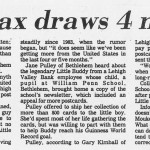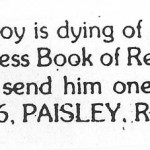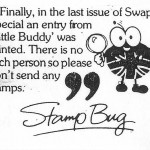David Cornwell and Sandy Hobbs | Dear Mr. Thoms... # 24, 1992
Notes on an investigation in progress
In September and October 1991, stories have been circulating amongst school children in parts of the West of Scotland concerning approaches by ill-intentioned adults dressed as clowns. We have been gathering information about these stories in various ways and would be glad of any help in pursuing them. In particular, we would welcome information concerning equivalent stories in other areas, now or in the past. In the meantime we present below some of what we have collected, along with a few preliminary comments.
We first became aware of the stories through an item in the Sunday Mail, 15 September 1991, headlined "Riddle of the Clowns: Police probe kids' scare".
Police chiefs are baffled by floods of reports that children are being scared by two mystery … CLOWNS.
One definite, genuine report was received in Hamilton on September 4.
It concerned one man dressed in a clown's outfit, driving a purple mini, and offering sweets to children.
Since then, Lanarkshire Police have been inundated with forty reports – of two clown men, in a blue van.
However, the reported sightings have failed to provide police with leads, despite a helicopter and extra patrols being used. Joe Hogan, Strathclyde region's divisional education officer for Lanark, has told teachers:
"As a precaution you should alert pupils and parents. Anyone who sees a suspect person should phone the police. But no direct approach should be made."
Initial claims put the clowns in the Blantyre, Cambuslang, and Hamilton areas. One headmaster had information about similar incidents around Lesmahagow. Biggar and Douglas.
A police spokesman said: “There could be a perfectly inno¬cent explanation, but we must have information.
Anyone who sees something sus¬picious should note details such as registration numbers and notify us immediately.”
Three days later, a friend rang one of us, SH, with a story of clowns which he had heard from a child in the Easterhouse area of Glasgow and which he suspected might be an urban legend. That same day, unknown to either, the story, "Schools alert over strangers", appeared in the Glasgow Evening Times, 18 September 1991.
Schools in Lanarkshire have put parents and children on the alert.
Education chiefs have put out a warning after continued sightings of people in clown outfits offering sweets to children.
Strathclyde Police last week advised parents and young school children to beware and not to accept sweets from, or speak to, strangers.
Now some schools in Lanark¬shire have written to parents warning them of the situation.
Numerous sightings have been made in the Blantyre, Cambuslang, Hamilton. Coatbridge, and Stonehouse areas of a man tourinlg in a blue transit van.
A spokesman for Strathclyde Region’s education department said: “The division has written to all schools in the area making them aware of the situation.”
The next day a colleague at work approach SH with a story he later recorded on tape.
Yesterday morning my child was reluctant to go to school and complained of a slight tummy ache. On previous occasions where that's happened she's gone to school and been fine afterwards. So she went to school as normal. On the way to school in the car, she happened to mention that a friend of her's had told her the previous day that there had been someone going round dressed in a clown's outfit giving sweets to children. I didn't take the story very seriously. Three hours later, I got a phone call from her childminder saying that Kerry had come home, the school had sent her home, and she was complaining of still having a sore stomach. The childminder then phoned back half an hour later to say that Kerry had been saying that a rumour was going -, a story was going round the school, that there were -, there was someone, a person or people, dressed in a clown's outfit, going round in a blue van, giving sweets to children, and that she was very anxious about this and this was going round the school. Following that call, I telephoned the headmaster who said that the rumour was right round the school, that to try and reassure the kids they had asked five parents to come at the interval into the playground and that they had also contacted the community involvement police. He also mentioned that he thought they had calmed the kids down but at lunchtime two girls had gone to the local newsagent's and seen the local newspaper with a photograph of a clown on the front page. It was in fact a promotional item. The two girls had returned to the school in a state which he described as being hysterical. When I went home and went to pick up the kids from school that evening, my son who is eleven, my daughter is eight, my son's eleven, told me that in fact there were three individuals that were going round, one with a Bart Simpson mask, one with a Ronald McDonald mask, and one with a turtle mask. They were driving around in a van that was disguised as a police van, throwing out bags of sweets to children, and that in fact the sweets were drugged. And my son became quite irate, quite distressed when it was put to him that really there was very little basis for that story.
Since we were also picking up the story from other sources now, we decided to try to estimate its extent, and possible variants, in a more systematic way. On Monday 23rd September, over a hundred post-graduate student teachers (whom we shall call Group A) would return to Jordanhill College from teaching practice in a wide variety of primary schools in the region. With the agreement of their tutors, DC presented them with a questionnaire.
Children’s encounters with strangers
I am interested in the extent of anxiety amongst children, teachers and parents concerning approaches to children by unwelcome strangers in public places.
I would be grateful if you would help in this inquiry by reporting anything relevant to such anxiety which you might have observed or heard about during your recent period in school.
Any information, however slight, might be of value.
If, on reflection, you decide that you have nothing relevant to report, please write "NIL" but complete the details requested at the bottom of the sheet.
Thank you for your help.
David Cornwell
It will be noted that this questionnaire was intentionally vague and did not mention clowns.
The results were as follows:
| Total number of respondents: |
103 |
| No information: |
36 |
| Information (no mention of clowns): |
36 |
| Information (mentioning clowns): |
31 |
In most cases more than one student visited each school. Expressed in terms of schools, we found that at least one report of the clown story in 22 out of the 58 schools (38%). Although the affected schools were predominantly in the area indicated in the press report, the story had reached some schools in outwith the area.
Subsequently DC obtained information from another, smaller group. These were first year BEd students (Group B) who had not yet had any teaching experience.
| Total number of respondents: |
16 |
| Information mentioning clowns: |
14 |
| Clown story heard from child: |
11 |
We shall now turn to a more detailed look at the content of what was reported by these two student groups, including, where appropriate, information from more informal sources.
A. Perspective
The students vary considerable in the attitude they appear to take up towards the story. There follow two comparatively short statements, one displaying scepticism, the other more accepting in outlook.
Respondent 02: Children in P2 were telling the teacher of men in vans dressed up as clowns. The headmistress tried to scotch the rumour, as no hard evidence was found. Teachers speculated that it might have been on the news some weeks passed; that could have been the catalyst.
Respondent 01: During my placement there was a lot of talk among the kids about a clown going around Coatbridge offering sweets, kidnapping the children and threatened to shoot a girl. However there is some truth in this as there was an incident of a shooting and kidnapping and a separate incident of a man dressed as a clown offering sweets. The school was alerted of this and a letter sent out to all parents which caused a lot of anxiety among the children and the teachers were worried to(o).
B. Story Content
Blue Van A van is a regular, but. not invariable, feature of the story. It is normally blue; on a couple of occasions it is specified to be an ice-cream van.
| Group |
Clown stories |
Van |
Blue |
| A |
31 |
17 |
13 |
| B |
14 |
10 |
4 |
One might wonder why such an apparently trivial detail as the type of vehicle~ and its colour~ should be so comparatively stable. If the story is treated as a warning, then it would be important to remember that the vehicle was a blue van, as this would be a sign of possible danger.
Names and Variants No regular name for the figures featured in these stories seems to have emerged~ "Killer Clowns" and "Bad Clowns" have both been used, but neither frequently. In any case, costumes other than clowns have appeared~ including monkeys, turtles and policemen. In one case the clowns were said to be gypsies, perhaps echoing a much more ancient fear.
The Approach The most common way in which the clowns are said to approach children is by giving or offering sweets. On a couple of occasions, it is an offer of face-painting that is made.
Outcome But what happens after the approach? That is more problematic. In some cases, the child enters the van or is just "taken away". Is something more being implied? With the exception of a single reference to rape, sex is not explicitly mentioned. However, it may be that an offer of sweets from a stranger is such a stereotyped introduction to events which end in sexual attack that the tellers take that outcome for granted. (It should be noted that the "tellers" are our adult informants; we have not been collecting from children directly.)
A few versions mention some sort of physical attack, the most interesting of which are those which seem to allude to the distinctive sort of cuts to the mouth attributed to the so-called "Chelsea Smilers" (Roud, 1989). It is not clear whether the phrase "Chelsea Smile" we have picked up here derives from the children or is adult labelling of a child's description. Only a couple of versions deal in more extreme violence, one of which we quote.
Respondent X12: I came home from college last week and my little sister (aged 9) told me a story of how a friend of hers had heard about men who wore clown masks and drove an ice cream van. These men (or women) were kidnapping children and chopping them up with big knifes and putting them in freezers and eating them for lunch. She also said that the blood was sold with the ice cream as raspberry sauce to get rid of the evidence. When I asked her if she was worried she said no because it was happening in schools near our house but her school is in Glasgow.
C. Sources and Effects
The reports from our informants include not simply story "texts" but also references to possible origins and to observed outcomes. Parents, police and the mass media are all cited as possible sources. One student reports that older children told the stories in order to frighten younger ones. Others appear to assume that the story derives from an actual incident, even although it may have become exaggerated in the telling.
In a number of cases the students appear to have had fairly direct experience of children becoming hysterical, set off, for example, by the approach of a van or a police helicopter. In another case, the response of children appears to have been more aggressive.
Respondent X05: In my son and daughter's Primary School the story of two men in a van dressed as clowns swept through the children. The tension in the children was quite noticeable. My own children were reassured by going over the list of "what to do if approached" that we had already decided on. My friend's son however became anxious about coming home for lunch because he would have to walk back to school alone. About a week after this there was an incident in the playground when some workmen next door were actually stoned by about a dozen children while many more watched. My own children were not involved but a friend's daughter was accused of throwing stones. This is entirely out of character for her.
D. Antecedents
As already mentioned above, one possible origin of such a story is an actual incident of the sort the story portrays. However, this by no means the only possibility. It has not been necessary for us to seek alternative explanations. Informants have suggested them to us. These include, at the local level, a road safety campaign aimed at school children and featuring a clown, balloon sellers who dress as clowns, and a promotional campaign for a brand of sweets featuring clowns. In the mass media, our attention has been drawn to It, a novel by Stephen King and a video based on it. The video was released for rental in Britain on 23rd August 1991; the poster advertising it in video shops features a sinister clown-figure.
We have not reviewed the literature on satanic abuse systematically, but have noted two cases, one in America (Nathan, 1990) and one in the Netherlands (Jonker and Jonker-¬Bakker, 1991), in which an abuser is alleged to have dressed as a clown. It is possible that such a notion could have been spread through satanic abuse seminars to those educationists who eventually give warnings to children.
Two final point of speculation. First, although clowns are figures which appear in adult entertainment, often devised for children, can we sure that children always regard them as amiable?
Secondly, there is the question of the time of year at which this has taken place. The Gorbals Vampire Hunt (Hobbs and Cornwell, 1988) took place in September, 1954. We wonder whether such events are more likely to take place at this time of year. September is a month when children are still able to play out of doors after school, making the spread of rumours easier. The next major children's calendar custom is Hallowe'en, associated with dressing up and with frightening figures.
References
Hobbs, Sandy and Cornwell, David, Hunting The Monster With Iron Teeth, pp 115-137 in Gillian Bennett and Paul Smith (Eds.) Monsters With Iron Teeth, Sheffield: Sheffield Academic Press, 1988.
Jonker, F. and Jonker-Bakker, P. Experiences With Ritualist Child Sexual Abuse, Child Abuse and Neglect 15, 1991, 191-196.
Nathan, Debbie. The Ritual Sex Abuse Hoax, Village Voice, 12 June 1990, 36-44.
Roud, Steve. Chelsea Smilers, Foaftale News 15, September¬1989, 1-2.
Acknowledgements
Thanks to all the students who responded to our questions and to John Brady, Donald Christie, Tony Clarke, Sheena Crozier, Janet Fabb, lain Ferguson, Kevin Hobbs, Effie Maclennan, lain McKechnie, Jim and Margaret McKechnie, Joan Menmuir, Gerry Mooney.




